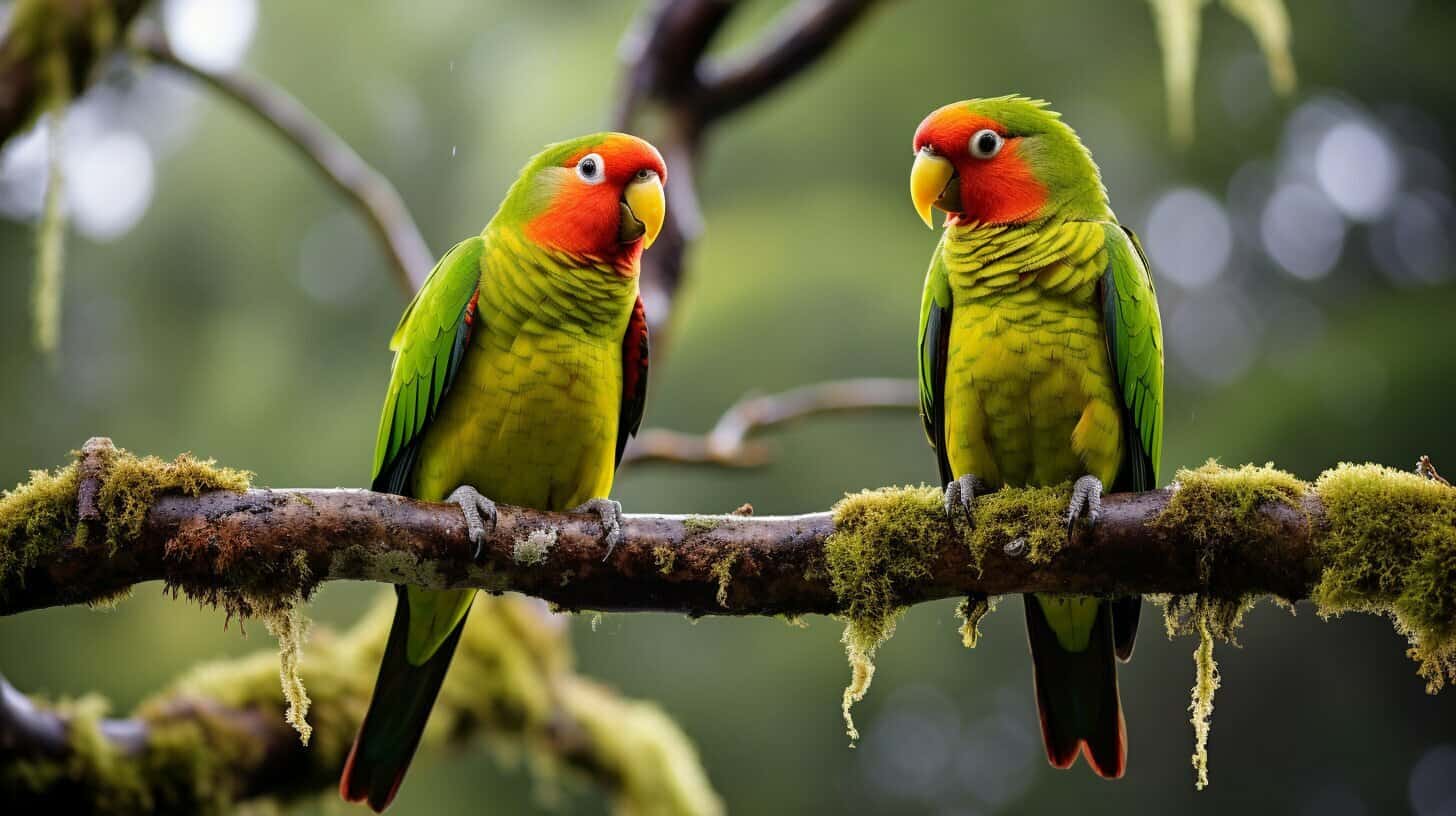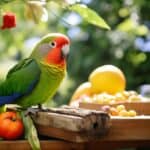Kakarikis are known for their playful and quirky personalities. They are popular with bird lovers due to their striking colours and ability to learn tricks. If you want a pet kakariki, you may also consider breeding these delightful birds. However, it’s important to understand the ideal breeding age and other important factors to ensure successful reproduction.
This article will explore the ideal age for kakarikis to start breeding. We will also discuss the range of ages at which Kakarikis typically breed and provide important information to ensure successful breeding. By the end of the article, you will better understand what it takes to breed these beautiful birds successfully.
What age do Kakarikis breed? The ideal age for kakariki breeding is around 1.5 years old when they have reached sexual maturity. Kakarikis are seasonal breeders, with their breeding season typically starting in late winter or early spring and ending in mid-summer. Proper nutrition, suitable nesting materials, and cage conditions are crucial for successful reproduction.
Key Takeaways
- The ideal breeding age for kakarikis is between 1 and 2 years old.
- Kakarikis typically breed in the spring and summer months.
- Providing a suitable nesting environment and proper nutrition is crucial for successful reproduction.
Understanding Kakariki Breeding Habits and Seasons
Breeding kakarikis requires an understanding of their natural breeding patterns and behaviours. Kakarikis are seasonal breeders, and their breeding season typically starts in late winter or early spring and ends in mid-summer. During this period, they become more active and vocal and show a greater interest in breeding.
Male kakarikis display aggressive behaviours towards other males to establish their dominance and attract a female mate. Once a pair has formed, they engage in pre-copulatory behaviours such as courtship displays, feeding each other, and vocalisations.
After mating, the female kakariki will lay an average of 4-6 eggs over several days. Incubation typically lasts around 21 days, after which the chicks hatch. The breeding pair will continue to care for the chicks for approximately 6-8 weeks.
It’s important to note that the breeding season is not the only time kakarikis can breed. In captivity, they can breed all year with proper care and conditions, but it’s important to provide them with a rest period between breeding cycles to prevent health issues.
Factors Affecting Kakariki Breeding
Several factors can affect the breeding success of kakarikis, including age, diet, and environment. Young birds that are not yet fully mature may have difficulty breeding, and older birds may experience health issues that can affect their breeding capacity.
Moreover, a nutritious and balanced diet is essential for breeding. A lack of certain nutrients can lead to egg-binding, a condition where the female cannot lay eggs due to a lack of calcium or improper nutrition.
The environment and cage conditions can also impact the breeding success of kakarikis. A suitable nesting box and materials, such as fresh wood shavings or grass, are important for successful breeding. The cage should be cleaned regularly, and the breeding pair should be separated from other birds to prevent aggression or stress.
In the next section, we will discuss the optimal age for breeding kakarikis and the important factors to consider when breeding them.
The Optimal Age for Kakariki Breeding
When it comes to breeding kakarikis, age is an important factor to consider to ensure the success of reproduction. The optimal age for kakariki breeding is typically between 1 and 2 years old, which is when they reach sexual maturity. However, it is important to note that breeding too early or too late may lead to complications and reduced fertility.
While it may be tempting to breed kakarikis as soon as they reach sexual maturity, waiting until they are at least 18 months old is generally recommended. This allows them to fully mature physically and emotionally, improving the chances of successful breeding.
On the other hand, waiting too long to breed kakarikis can also lead to complications. As they age, their fertility may decrease, and they may be more susceptible to health problems affecting their reproduction ability. Therefore, finding a balance and determining the best age for your specific kakariki pair is important.
Factors such as genetics, diet, and environment can also affect the optimal breeding age for kakarikis. Providing them with a balanced and nutritious diet, plenty of space for exercise and play, and a comfortable and stress-free environment to support their overall health and well-being is important.
Additionally, it is recommended to consult with a veterinarian or experienced avian breeder to determine the best age and conditions for breeding your specific kakariki. They may be able to provide valuable insights and advice to ensure the success of your breeding efforts.
Methods and Care for Successful Kakariki Reproduction
When it comes to breeding kakarikis, providing optimal care is crucial for successful reproduction. Here are some methods and tips to consider:
Nesting Materials
It’s essential to provide suitable nesting materials to create a comfortable and secure environment for the breeding pair. Opt for softwood shavings or chopped straw in a nesting box or coconut shell to replicate their natural habitat. Avoid using cedar or pine shavings, as they can cause respiratory issues.
Cage Conditions
Ensure that the breeding pair has enough space to move around comfortably. A cage of at least 3 feet wide, 2 feet deep, and 3 feet high is ideal. Provide enough perches, food dishes, and water for the pair. Keep the cage in a quiet and dimly lit area to reduce stress, which can affect breeding.
Nutrition
Proper nutrition is vital for successful breeding. Feed the pair a balanced diet that includes high-quality pellets, fresh fruits, and vegetables. Supplement their diet with calcium and vitamin D during the breeding season to support egg production and development.
Monitoring the Breeding Process
Monitor the breeding process carefully to determine if the pair is mating and producing eggs. If the pair doesn’t mate, pair them with a different partner. And if the female doesn’t lay eggs, provide more calcium and vitamin D supplements.
It’s crucial to note that breeding can be stressful for kakarikis, so monitor their behaviour and look out for signs of distress. If you notice abnormal behaviour or changes in their usual routine, seek veterinary care immediately.
Conclusion
Successful breeding of kakarikis requires careful consideration of several key factors. The ideal age for kakariki breeding is typically between one and two years old, although it may vary depending on their individual development and health. It is crucial to understand kakarikis’ breeding habits and seasons to identify the best time to breed them in a domestic setting.
Providing suitable nesting materials, optimal cage conditions, and proper nutrition is essential for supporting successful reproduction. Maintaining a close eye on the breeding pair and monitoring their health and behaviour can help identify potential issues and ensure their well-being.
In summary, breeding kakarikis can be a rewarding experience, but it requires careful planning and attention to detail. By considering their age, breeding habits, and care requirements, you can increase your chances of successfully breeding these charming birds.
FAQ
Q: What age do kakarikis breed?
A: Kakarikis typically start breeding between the ages of 1 and 2 years old.
Q: What is the best breeding age for kakarikis?
A: The ideal age for kakariki breeding is around 1.5 years old, when they have reached sexual maturity.
Q: What is the breeding age range for kakarikis?
A: Kakarikis can breed within a range of 1 to 4 years old, but the most successful breeding usually occurs between 1 and 2 years old.
Q: When do Kakarikis start breeding?
A: Kakarikis typically start breeding in the spring or early summer, which aligns with their natural breeding season in the wild.
Q: What are the breeding habits of kakarikis?
A: Kakarikis are monogamous birds and form strong pair bonds. They are cavity nesters and will find or create a suitable nest for breeding.
Q: When is the Kakariki breeding season?
A: The kakariki breeding season occurs during the spring and early summer when there is abundant food and favourable weather conditions.
Q: What is the optimal age for kakariki breeding?
A: The optimal age for kakariki breeding is between 1.5 and 2 years old when they have reached sexual maturity and are in good health.
Q: How long should I wait for kakarikis to breed?
A: It is recommended to wait until kakarikis are at least 1 year old before attempting breeding, but waiting until they are around 1.5 to 2 years old is even better.
Q: What methods can I use for successful kakariki reproduction?
A: Providing suitable nesting materials, creating an optimal cage environment, and offering a balanced diet are essential for successful kakariki reproduction.
Q: How can I care for breeding kakarikis?
A: To care for breeding kakarikis, it is important to monitor their behaviour, provide a comfortable nesting area, ensure their nutritional needs are met, and provide regular veterinary check-ups.



Have comments or questions about this article? Then get involved!
Spotted an error or something we have missed? Let us know